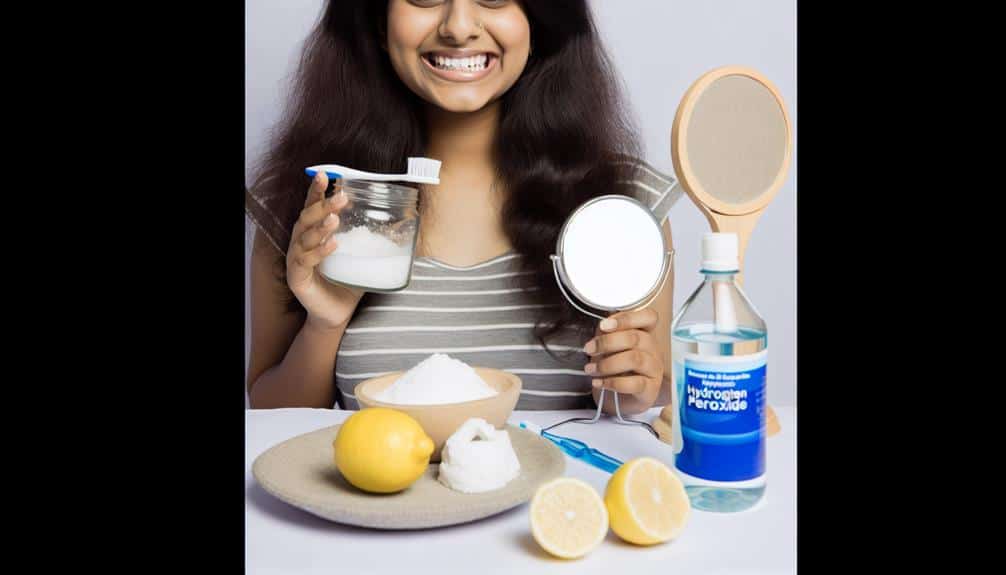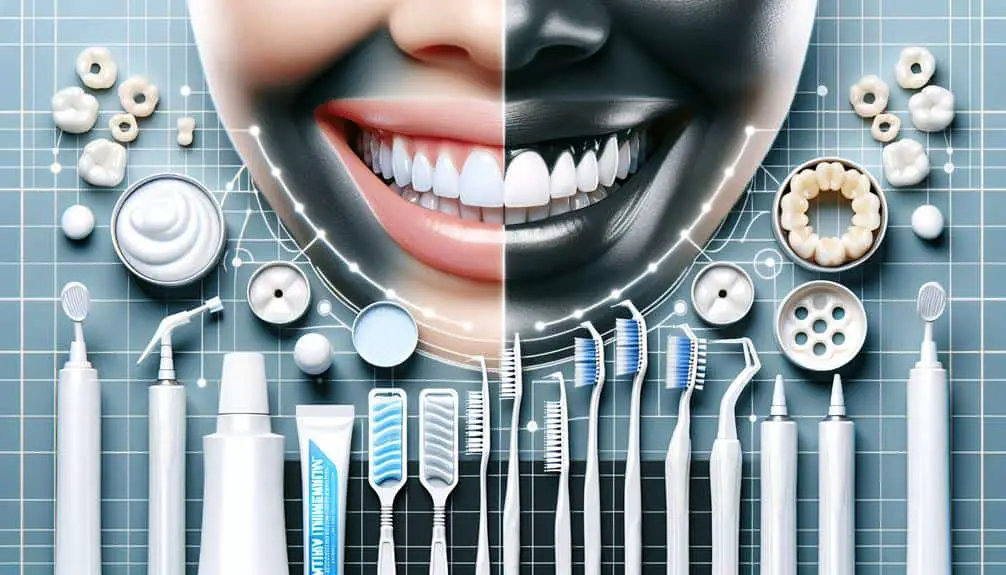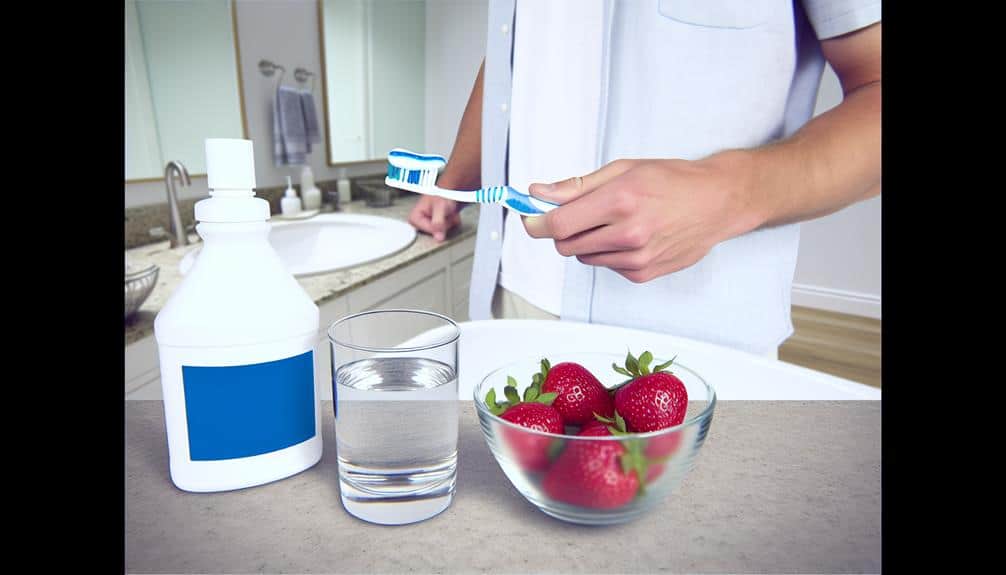Brighten stubborn teeth spots naturally with these DIY solutions: try a baking soda and lemon paste for a gentle scrub and bleaching effect, but use sparingly to protect enamel. Coconut oil pulling, an ancient practice, can gradually whiten teeth with its antimicrobial properties. Opt for a hydrogen peroxide rinse mixed with water for a safe and effective whitening solution. Activated charcoal scrub absorbs stains effectively, especially from coffee or tea, with consistent use showing noticeable results. Finally, a mixture of strawberries and baking soda acts as a natural astringent while gently scrubbing away surface stains. These methods offer a potent way to enhance your smile.
Key Points
- Baking Soda and Lemon Paste: Natural abrasive with bleaching properties, use sparingly.
- Coconut Oil Pulling: Ancient method for antimicrobial benefits and gradual whitening.
- Hydrogen Peroxide Rinse: Safe and effective for whitening, limit use to prevent irritation.
- Activated Charcoal Scrub: Absorbs toxins, lifts stains, effective for surface discoloration.
- Strawberry and Baking Soda Mix: Malic acid whitens gently, promotes dental health with regular use.
Baking Soda and Lemon Paste
To effectively whiten your teeth using a natural method, consider making a paste using baking soda and lemon. Baking soda acts as a mild abrasive that helps scrub away surface stains on your teeth. When combined with the acidic properties of lemon, which acts as a natural bleaching agent, this paste can aid in removing tooth discoloration. However, it's important to emphasize that the acidic nature of lemon can potentially erode the enamel of your teeth if used excessively. Therefore, it's recommended to use this mixture sparingly and not as a daily routine to protect your oral health.
Natural remedies like the baking soda and lemon paste provide an alternative solution for those seeking to whiten their teeth without harsh chemicals. While these ingredients can be effective in brightening your smile, it's crucial to be mindful of their acidic nature and use them in moderation to maintain good oral health.
Coconut Oil Pulling Method
Consider incorporating the coconut oil pulling method into your dental routine to potentially enhance the whiteness of your teeth naturally. This ancient practice is rooted in Ayurvedic medicine and is known for its oral hygiene benefits. To try this natural remedy, swish one tablespoon of coconut oil in your mouth for about 15-20 minutes, making sure not to swallow any of it. The oil supposedly pulls out toxins and bacteria from your mouth, which could contribute to teeth discoloration.
Coconut oil contains lauric acid, known for its antimicrobial properties, making it a popular choice for oral care. Regular oil pulling may help reduce plaque buildup, improve gum health, and freshen your breath. While it may not provide instant whitening effects, consistent use over time could lead to gradual improvements in the brightness of your teeth.
Hydrogen Peroxide Rinse
Enhance your teeth-whitening routine by incorporating the hydrogen peroxide rinse, a method known for its potential to brighten your smile effectively. Hydrogen peroxide can be an excellent addition to your oral care regimen, offering both oral health benefits and a natural teeth remedy.
Here are some tips to make the most out of this DIY solution:
- Dilute Properly: Mix hydrogen peroxide with an equal amount of water to create a safe and effective rinse.
- Swish Gently: Swish the solution around your mouth for about 30 seconds to 1 minute, ensuring it reaches all teeth surfaces.
- Avoid Swallowing: Although safe in small amounts, hydrogen peroxide shouldn't be ingested, so be cautious while rinsing.
- Limit Frequency: Use the rinse only a few times a week to prevent irritation or sensitivity in your mouth.
- Monitor Progress: Keep track of any changes in the color of your teeth to gauge the effectiveness of the rinse.
Activated Charcoal Scrub
For a natural way to brighten your smile, try incorporating an activated charcoal scrub into your teeth-whitening routine. Activated charcoal is known for its ability to absorb toxins and stains, making it a popular ingredient in teeth whitening products. When used as a scrub, activated charcoal can help remove stubborn stains caused by coffee and tea discoloration.
To make an activated charcoal scrub at home, mix a small amount of activated charcoal powder with water to form a paste. Gently brush the paste onto your teeth, focusing on areas with coffee stains or tea discoloration. Allow the scrub to sit on your teeth for a few minutes before rinsing thoroughly.
Activated charcoal works by binding to the surface of your teeth and lifting away stains, revealing a brighter smile. It's important to note that while activated charcoal can be effective in removing surface stains, it may not have the same impact on deeper discoloration. Consistency is key when using this scrub to see noticeable results over time.
Strawberry and Baking Soda Mixture
To further brighten your smile using natural ingredients, explore the benefits of a strawberry and baking soda mixture for teeth whitening. Strawberries aren't only delicious fruits but also contain malic acid, which can help remove surface stains on teeth. When combined with baking soda, which is known for its mild abrasive properties, this mixture can be an effective natural remedy for whitening stubborn teeth spots.
Here are five reasons why this DIY solution can be beneficial for your teeth:
- Strawberries are rich in vitamin C, which can help break down plaque that causes discoloration.
- The malic acid in strawberries can act as a natural astringent to remove surface stains.
- Baking soda can gently scrub away stains without being too harsh on your enamel.
- This mixture provides a natural alternative to commercial whitening products that may contain harsh chemicals.
- Regular use of this remedy may help maintain a brighter smile over time, promoting overall dental health.
Frequently Asked Questions
Are There Any Potential Side Effects or Risks Associated With Using These DIY Whitening Methods?
When using DIY whitening methods, potential risks like enamel damage and gum irritation could occur. Sensitivity concerns may arise, causing discomfort. It's important to follow instructions carefully and consult a dental professional if you experience any issues.
How Long Does It Typically Take to See Results From Using These DIY Whitening Solutions?
Typically, DIY whitening solutions show progress within a week, but results vary. Monitoring closely helps. Success stories mention noticeable changes in 2-4 weeks. Personal experiences suggest patience for lasting outcomes. Consistency is key for effective progress monitoring and timeline adherence.
Can These Methods Be Used on Sensitive Teeth Without Causing Irritation?
To manage sensitivity when whitening teeth, consider tooth enamel protection. DIY alternatives can be gentle, but professional treatments offer precision. Always consult a dentist for tailored advice to prevent irritation and guarantee effective results.
Are These DIY Solutions Safe to Use for Individuals With Dental Restorations Such as Crowns or Veneers?
When it comes to DIY whitening, it's essential to take into account dental restorations like crowns or veneers. Precautions are necessary to guarantee safety. Consult your dentist before using any DIY solutions to avoid harming dental restorations.
Is It Necessary to Follow up With Regular Professional Dental Cleanings and Whitening Treatments When Using These DIY Solutions for Whitening Stubborn Teeth Spots?
When using DIY solutions for whitening stubborn teeth spots, it's crucial to understand the balance between home care and professional treatments. Regular dental cleanings and whitening treatments can improve DIY results and guarantee long-term oral health.



